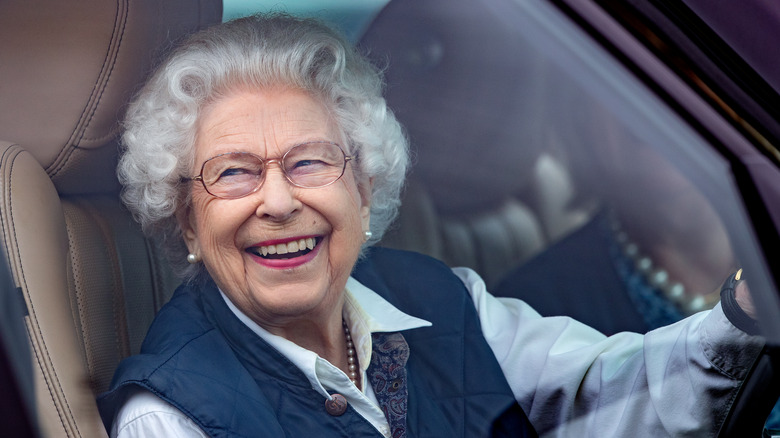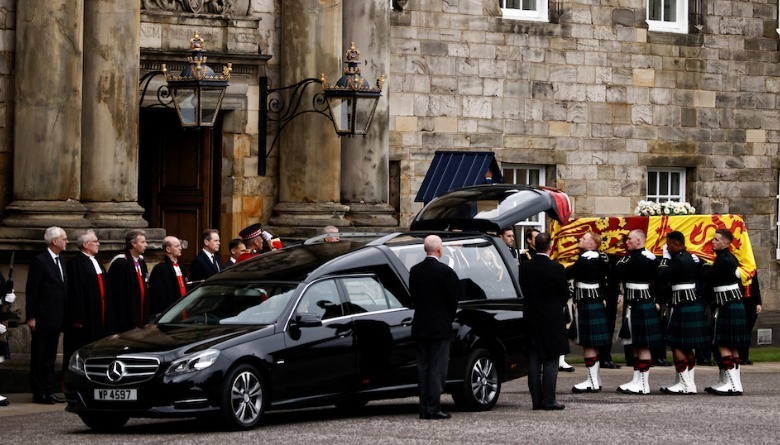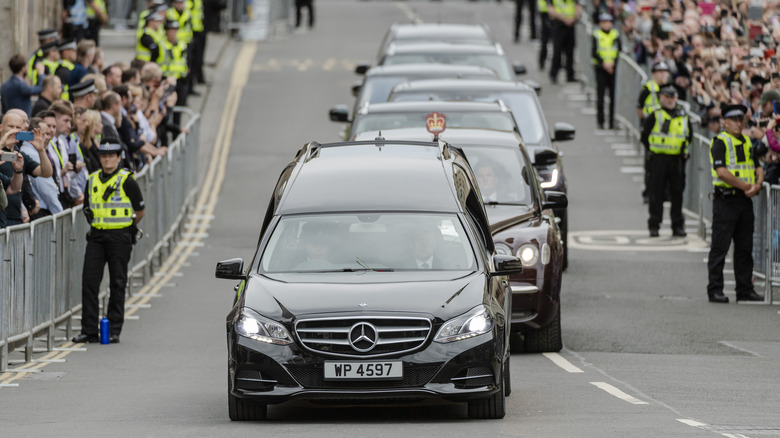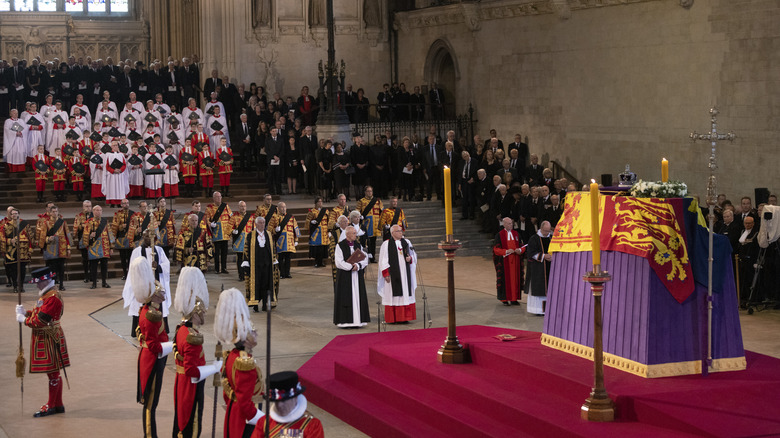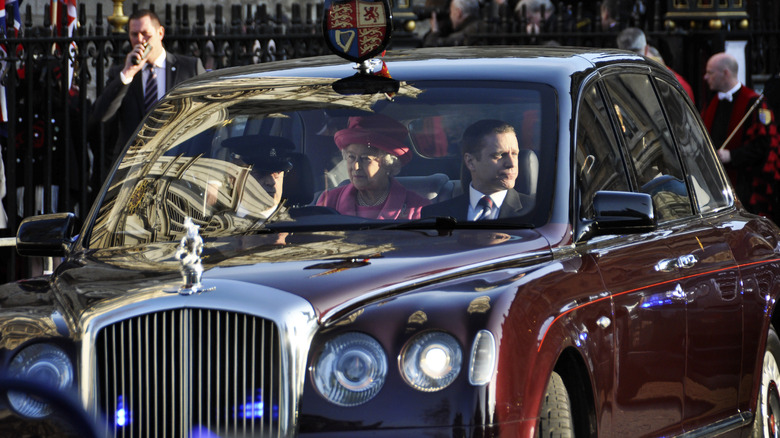The Unexpected Car Taking Queen Elizabeth To Her Funeral
Last week, when the Queen of England Elizabeth II passed away at the age of 96, most thought that the hearse leading the procession through Scotland would be something quintessentially British, like a Bentley, Range Rover, Jaguar, or Rolls-Royce — marques which have featured multiple times in her own private collection. But the vehicle carrying the coffin though Scotland was from the other side of the English Channel. It's a decidedly German vehicle, in fact, a Mercedes E-Class.
The Queen was known to be driven around in a fleet of Range Rovers and was quite fond of her bespoke pair of Bentley limousines. A German vehicle is not the first hearse most people would think of. Members of the Royal Family who passed away in previous years were carried to their final resting places by modified Jaguars and Land Rovers. Prince Philip, Elizabeth II's late husband, was famously quoted as saying "Just stick me in the back of a Land Rover and drive me to Windsor."
But the Mercedes E-Class carrying the Queen is no ordinary station wagon converted to carry a casket. It's more local than the Mercedes badge on the grille suggests.
A Scottish Mercedes
The hearse carrying the Queen was custom built by Binz International, and supplied to William Purve Funeral Directors of Scotland, according to Fox News. The Edinburgh-based company has been outfitting hearses for decades, and was contracted by the Royal Family with the important task of supplying the Queen's transportation.
It's no secret the Queen loved Scotland, and it's only fitting that an Edinburgh-built hearse would accompany her during her final ride through the Scottish countryside. Most William Purve hearses are painted silver, but the Queen's is decked out in a somber black. It's a muted livery for the solemnity of the occasion.
The Mercedes hearse carried the Queen through Scotland to St. Giles Cathedral, where after a period of laying in rest for people to pay their final respects, it will be flown to London for a large procession later this week (via Reuters). That will see the coffin borne on a gun carriage of The King's Troop Royal Horse Artillery from Buckingham Palace to the Palace of Westminster on Wednesday, September 14, 2022, it was announced, a fitting tribute to both the Queen and her long-reigning legacy.
The leadup to the Queen's funeral is currently ongoing
The Queen's funeral is due to take place on Monday, September 19, with the actual service set for Westminster Abbey at 11 a.m. GMT, which is around 6 a.m. ET. However, a monarch's send-off is a long process, and various major events occur between the head of state's death and the funeral service itself. The entire chain of events occurs during an official mourning period, where the nation pays its respects to its departed leader. Sports events have been postponed, TV schedules have changed, and tributes have taken place at gatherings across Britain (via BBC).
The Queen's body spends time at a number of locations. At the time of writing, it is lying in state at Westminster Hall, where the public can file past and pay their respects. Some of the Queen's more dedicated subjects have been waiting in line for days. Previously, the Queen's coffin has spent time at the Palace of Holyroodhouse in Scotland, and a night at the monarch's main residence: Buckingham Palace in London.
Each step of the journey is broken up by processions; one took place down Edinburgh's Royal Mile, and another from Buckingham Palace to Westminster down London's Mall. Senior members of the royal family, including the newly crowned King Charles III, have been at the heart of the proceedings, one of which saw the Queen's four children perform a 10-minute vigil around her coffin in one of the country's more recent traditions. It was first performed after the death of George V in 1936 (via Town and Country).
The Mercedes isn't the only unique vehicle associated with the Queen
It's quite fitting that her final journey is taking place in a unique vehicle as Queen Elizabeth II was always fond of cars. She was also no ordinary motorist, as most of the laws of the United Kingdom don't actually apply to its monarch. Despite being spotted behind the wheel fairly regularly, the Queen did not have a driver's license, and there was no legal requirement forcing her to pass a driving test like everyone else had to. Speed limits were also not applicable to Her Majesty in many circumstances, and Elizabeth II was more or less free to tear down her nation's streets at whatever velocity she desired, at least at least with a police escort (via Insider).
However, unlike her dearly departed husband who managed to roll the family Land Rover back in 2019, the queen seemed to be a fairly careful driver. That was probably for the best as she had access to the kind of vehicles no one wants to write off. The monarch actually owned the world's second most expensive car at one point — a custom Bentley that served a similar purpose to the U.S. president's limo. As well as being built to withstand bomb blasts and gas attacks, the queen's custom Bentley also featured special doors that helped the elderly figurehead get in and out of the vehicle. The cabin was built for visibility and the vehicle's reclining seats were upholstered in lambswool. The royal collection also included a classic Aston Martin DB6, a number of off-road vehicles, a Rolls-Royce, and curiously enough, a hybrid.
